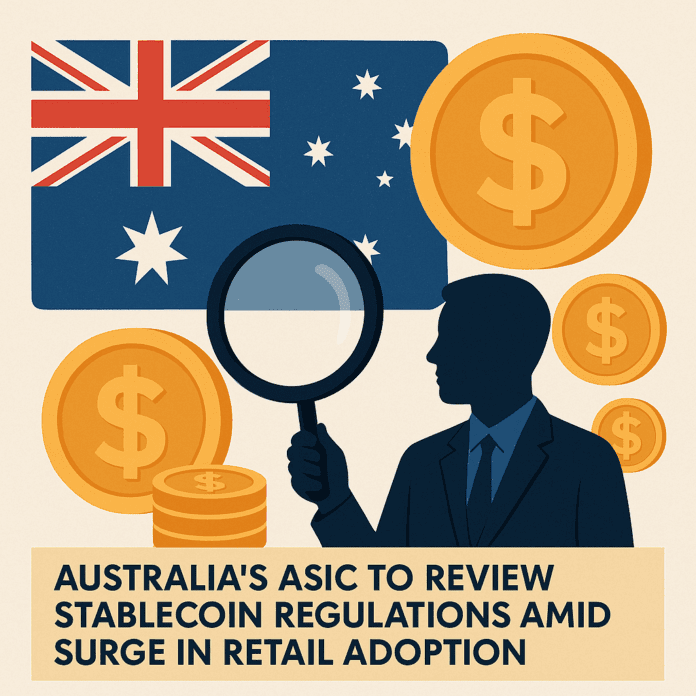ASIC, the Australian Securities and Investments Commission, is going to take a closer look at existing regulations as they relate to stablecoins. With a recent surge in retail adoption among these tokens, there is more demand than ever before, and ASIC is hoping to stay ahead of the curve.
Stablecoin Regulation
As part of CP 381 proposed in December 2024, ASIC issued a series of regulations about stablecoins. The organisation stated that non-interest-bearing stablecoins, ones that are fiat-backed and pegged to AUD 1:1, can be constituted as a financial product recognised in the form of a non-cash payment facility (NCPF).
This move alone could have far-reaching impacts on issuers who have AFS licences required to issue regulated stablecoins, as well as on other participants in the industry that sell, buy, or use stablecoins as part of their business. Centralised exchanges would need to apply for an AFS licence in order to “make a market” for that regulated stablecoin. Any marketplaces that facilitate the trading of these coins may find themselves required to acquire an Australian market licence as well.
Growth in stablecoin adoption has been a primary factor behind these regulations. The move also stems from the fact that the Corporations Act makes it possible for payments to be made by passing ownership of non-cash payment facilities from one person to another.
The proposed reforms to Australia’s payments licencing framework for digital asset platforms may not ultimately align with these changes. Consultation on these reforms was done by the government at the end of 2023, but legislation has not yet been drafted to put those reforms into effect.
ASIC Evolving Licensing
One of the main takeaways from the aforementioned CP 381 is ASIC’s stance on market licencing regimes and how they apply to digital assets considered financial products, not to mention entities that are providing financial services related to those products.
AFS Licencing Requirements. Compliance requirements for AFC licensees—financial requirements, conflicts of interest, dispute resolution, organisational competence, etc.—apply equally to a digital asset business that requires AFS licencing.
AFS Licencing Proofs. Any existing proofs will be treated as adequate, and we won’t require any digital asset business to submit new proofs. ASIC may request additional information but plans to only seek it through the issuing of requisitions.
AFS Licence Authorisations. Any existing AFS licence authorisation options will be designed to allow appropriate businesses to engage in activities involving financial products other than digital assets. These derivatives don’t require margin or leverage requirements, nor do they act as a facility when it comes to making financial investments.
Growing Crypto Adoption
One of the stark realities facing ASIC is that crypto adoption is on the rise. In just a few short years, the market has boomed, and now it has become a permanent part of how people store value, make online payments, and invest. The underlying numbers are even more impressive.
The growth of the crypto marketplace shows that there is a substantial transformation going on when it comes to Australia’s crypto technology. It shows that there is a greater acceptance of digital currencies as a legitimate means of investment and payment. In the online casino sector, the biggest growth can be seen as more entities are now supporting crypto payments.
Record Numbers
Reporting indicates that nearly 32.5% of all Australians either currently own cryptocurrency or have in the past. Coupled with the fact that an estimated 95% of Australians are at least aware of a cryptocurrency, and signs indicate that the growth that we have seen is far from over.
Nearly 15% of Austrians indicated that they would like to invest in a cryptocurrency, but they haven’t because of economic concerns. While some of that crowd will simply remain too conservative to take the next step, it is likely that at least some of them will progress forward.
Furthermore, nearly 43% of Australians believe that crypto will at some point become widely accepted not only by the people but by Australian businesses as well. This could be the move that leads to an even higher retail adoption rate among Australians. The numbers already indicate rapid growth, which leads to challenges for regulatory bodies like ASIC when it comes to staying ahead of the curve.
Young Investors Leading the Charge
Several key statistics are important to consider when discussing the growing adoption rate of crypto in Australia. Perhaps the most significant aspect to discuss is how the younger generations are spearheading this trend.
Young adults, those in the 25-34 range, are considered to be at the forefront of the crypto trend. More than half (53%) of young adults reported crypto ownership of some kind. Men are the most dominant force within that age range, though 21.9% of women in the 25-34 range did report owning digital assets in 2025.
Confidence is growing.
One of the largest barriers to entry for many is general confidence as it relates to crypto. That said, crypto is seen as a much more trustworthy asset as confidence continues to grow. Part of the explanation has to do with more than 57% of crypto holders reporting profits in 2025, up substantially from 37% who reported profits in 2024.
Those who have been in the game longer—more than six years—have reported that they are doing even better than that. Long-term investors, 73.5% of them, claimed to have seen capital gains. Such success is a positive indicator that strategy and patience can pay off, particularly with long-term assets like Ethereum and Bitcoin.
Regulations Still Present Challenges
Though the regulatory landscape has changed exponentially in Australia, there are still issues to contend with. For starters, regulation in the country still brings with it quite a bit of uncertainty. The government has been working to tighten reporting and tax rules so that they align with current OECD standards. That would include requirements for both custodians and exchanges to disclose user data for taxation.
Enforcement of these rules is also a frustrating point for investors. Reports show that nearly 20% of investors say that they’ve had to deal with issues or regulations from banks when it comes to trying to move their funds in or out of crypto-related platforms.
A Bright But Changing Future
The growth in adoption numbers should be a positive indicator that Australia is becoming a place for substantial crypto growth. The government is taking all necessary steps to make the area safer, more secure, and more appealing to investors, but it’s unclear where those numbers will stop.
ASIC will no doubt continue to tweak regulations to find the right spot for everyone. As the number of investors continues to rise, ASIC faces challenges to stay ahead of the curve and remain at the forefront of the global crypto marketplace.

